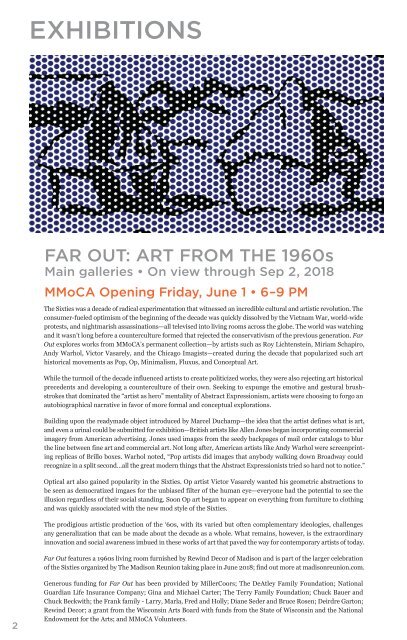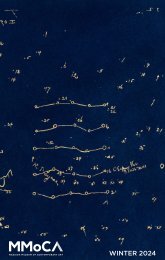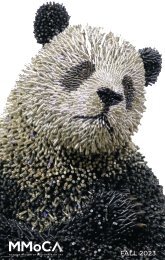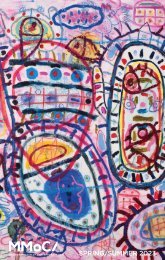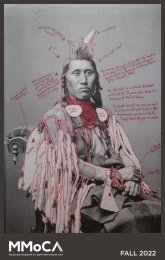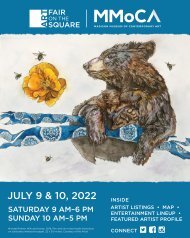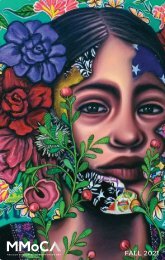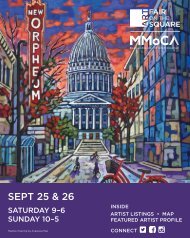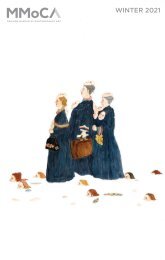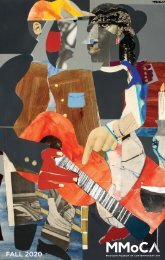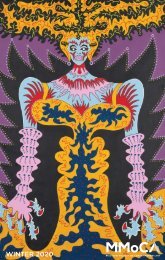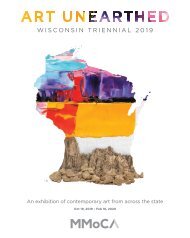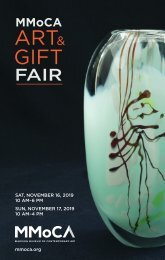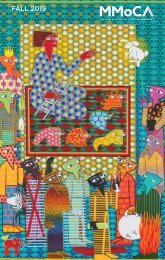Summer 2018 MMoCA newsletter
Newsletter of the Madison Museum of Contemporary Art, with articles about exhibitions (Far Out: Art from the 1960s, Art/Word/Image, Irene Grau: construction season, and The House of Sparkling Glasses: A Celluloid Experience by M.J. Paggie), events, education, and supporting the arts.
Newsletter of the Madison Museum of Contemporary Art, with articles about exhibitions (Far Out: Art from the 1960s, Art/Word/Image, Irene Grau: construction season, and The House of Sparkling Glasses: A Celluloid Experience by M.J. Paggie), events, education, and supporting the arts.
Create successful ePaper yourself
Turn your PDF publications into a flip-book with our unique Google optimized e-Paper software.
EXHIBITIONS<br />
FAR OUT: ART FROM THE 1960s<br />
Main galleries • On view through Sep 2, <strong>2018</strong><br />
<strong>MMoCA</strong> Opening Friday, June 1 • 6–9 PM<br />
The Sixties was a decade of radical experimentation that witnessed an incredible cultural and artistic revolution. The<br />
consumer-fueled optimism of the beginning of the decade was quickly dissolved by the Vietnam War, world-wide<br />
protests, and nightmarish assassinations—all televised into living rooms across the globe. The world was watching<br />
and it wasn’t long before a counterculture formed that rejected the conservativism of the previous generation. Far<br />
Out explores works from <strong>MMoCA</strong>’s permanent collection—by artists such as Roy Lichtenstein, Miriam Schapiro,<br />
Andy Warhol, Victor Vasarely, and the Chicago Imagists—created during the decade that popularized such art<br />
historical movements as Pop, Op, Minimalism, Fluxus, and Conceptual Art.<br />
While the turmoil of the decade influenced artists to create politicized works, they were also rejecting art historical<br />
precedents and developing a counterculture of their own. Seeking to expunge the emotive and gestural brushstrokes<br />
that dominated the “artist as hero” mentality of Abstract Expressionism, artists were choosing to forgo an<br />
autobiographical narrative in favor of more formal and conceptual explorations.<br />
Building upon the readymade object introduced by Marcel Duchamp—the idea that the artist defines what is art,<br />
and even a urinal could be submitted for exhibition—British artists like Allen Jones began incorporating commercial<br />
imagery from American advertising. Jones used images from the seedy backpages of mail order catalogs to blur<br />
the line between fine art and commercial art. Not long after, American artists like Andy Warhol were screenprinting<br />
replicas of Brillo boxes. Warhol noted, “Pop artists did images that anybody walking down Broadway could<br />
recognize in a split second…all the great modern things that the Abstract Expressionists tried so hard not to notice.”<br />
Optical art also gained popularity in the Sixties. Op artist Victor Vasarely wanted his geometric abstractions to<br />
be seen as democratized imgaes for the unbiased filter of the human eye—everyone had the potential to see the<br />
illusion regardless of their social standing. Soon Op art began to appear on everything from furniture to clothing<br />
and was quickly associated with the new mod style of the Sixties.<br />
The prodigious artistic production of the ‘60s, with its varied but often complementary ideologies, challenges<br />
any generalization that can be made about the decade as a whole. What remains, however, is the extraordinary<br />
innovation and social awareness imbued in these works of art that paved the way for contemporary artists of today.<br />
Far Out features a 1960s living room furnished by Rewind Decor of Madison and is part of the larger celebration<br />
of the Sixties organized by The Madison Reunion taking place in June <strong>2018</strong>; find out more at madisonreunion.com.<br />
2<br />
Generous funding for Far Out has been provided by MillerCoors; The DeAtley Family Foundation; National<br />
Guardian Life Insurance Company; Gina and Michael Carter; The Terry Family Foundation; Chuck Bauer and<br />
Chuck Beckwith; the Frank family - Larry, Marla, Fred and Holly; Diane Seder and Bruce Rosen; Deirdre Garton;<br />
Rewind Decor; a grant from the Wisconsin Arts Board with funds from the State of Wisconsin and the National<br />
Endowment for the Arts; and <strong>MMoCA</strong> Volunteers.


